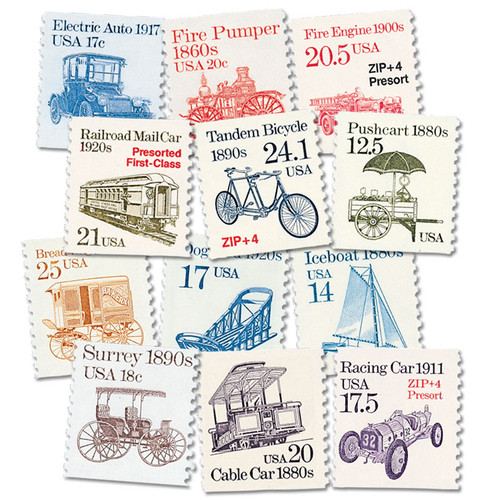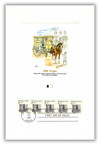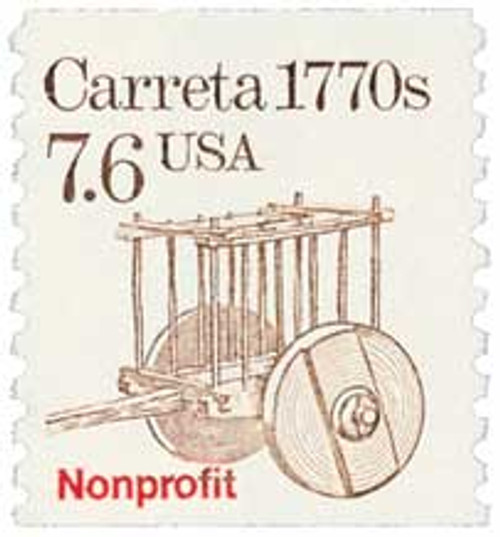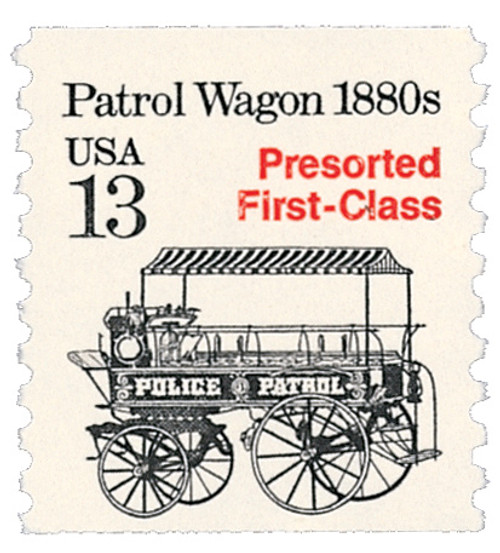
# 2253 - 1987 5c Transportation Series: Milk Wagon, 1900s
U.S. #2253
1987 5¢ Milk Wagon, 1900s
Transportation Series
- Pictures a 1900s milk wagon, based on photos from the Smithsonian
- 32nd stamp in Transportation Series
Stamp Category: Definitive
Series: Transportation
Value: 5¢, for use in covering several different make-up rates
First Day of Issue: September 25, 1987
First Day City: Indianapolis, Indiana
Quantity Issued: 23,800,000
Printed by: Bureau of Engraving and Printing
Printing Method: Engraved
Format: Coils of 100 and 3,000
Perforations: 10 vertical
Color: Black
Why the stamp was issued: This stamp replaced the 1983 5¢ Motorcycle stamp, which had been printed on the old Cottrell press that was no longer in use. To satisfy collectors, the USPS created a new design, rather than re-engraving an old one.
About the stamp design: This stamp was designed by Lou Nolan. He created a pen and ink drawing based on photos of an old milk wagon provided by the Smithsonian.
First Day City: The First Day ceremony for this stamp was held at the INDYPEX stamp show in Indianapolis, Indiana.
About the Transportation Series: On May 18, 1981, the USPS issued the first stamp in the Transportation Series, US #1907, picturing the Surrey, a doorless four-wheeled carriage. For the first time in US history, a coil stamp featured its own unique design rather than simply copying that of the current definitive stamp. Over 50 more coil stamps would be issued over the course of the next 15 years, each picturing a different mode of transportation. All of these types of transportation were used since American independence.
The various denominations provided face values to exactly match the rates for several categories of Third-Class mail (bulk rate and quantity-discounted mail). As the rates changed, new stamps with new values were added. Never before had a stamp series included so many fractional cent values.
The Bureau of Engraving and Printing printed most of the stamps in the Transportation Series, although private contractors printed a few. All but a few of the later stamps were produced by engraved intaglio. Differences in precancels, tagging, paper and gum provide a large number of varieties.
Scott Catalog separates the Transportation stamps into four groups. The stamps in the first group (#1897-1908) generally have the denomination in small type with a “c” next to it. These stamps were printed on the Cottrell rotary press, which joined together two plates to make a sleeve. The gaps between these plates created depressions where ink would collect and create joint lines on the stamps. Later issues were printed on a different press and didn’t have these joint lines.
The second group (#2123-36) had larger numbers with no “c.” The third group (#2252-66) was similar in appearance to the second group, but service inscriptions were added to the designs. These stamps also used a variety of paper and gum as well as different types of tagging. The fourth group (#2451-68) marked the end of fractional values. Now bulk mailers would use either the 5¢ or 10¢ stamp and then pay the difference from the actual postage rate.
The last stamp in the Transportation Series, the 20¢ Cog Railway, was issued on June 9, 1995, at the TEXPEX ’95 stamp show in Dallas, Texas. This marked the end of the largest US definitive series up to that time. Three new series would eventually replace it – American Transportation, American Culture, and American Scenes. Additionally, the Great Americans would go on to become the largest American definitive series.
History the stamp represents: From the 1850s to the mid-1930s, home delivery was the most practical way for dairies to sell their milk, and the milk wagon became a popular sight on town and city streets. Eventually, trucks began to replace the wagons during the 1920s, and by the 1940s, the amount of milk sold in stores exceeded the amount sold on delivery routes.
U.S. #2253
1987 5¢ Milk Wagon, 1900s
Transportation Series
- Pictures a 1900s milk wagon, based on photos from the Smithsonian
- 32nd stamp in Transportation Series
Stamp Category: Definitive
Series: Transportation
Value: 5¢, for use in covering several different make-up rates
First Day of Issue: September 25, 1987
First Day City: Indianapolis, Indiana
Quantity Issued: 23,800,000
Printed by: Bureau of Engraving and Printing
Printing Method: Engraved
Format: Coils of 100 and 3,000
Perforations: 10 vertical
Color: Black
Why the stamp was issued: This stamp replaced the 1983 5¢ Motorcycle stamp, which had been printed on the old Cottrell press that was no longer in use. To satisfy collectors, the USPS created a new design, rather than re-engraving an old one.
About the stamp design: This stamp was designed by Lou Nolan. He created a pen and ink drawing based on photos of an old milk wagon provided by the Smithsonian.
First Day City: The First Day ceremony for this stamp was held at the INDYPEX stamp show in Indianapolis, Indiana.
About the Transportation Series: On May 18, 1981, the USPS issued the first stamp in the Transportation Series, US #1907, picturing the Surrey, a doorless four-wheeled carriage. For the first time in US history, a coil stamp featured its own unique design rather than simply copying that of the current definitive stamp. Over 50 more coil stamps would be issued over the course of the next 15 years, each picturing a different mode of transportation. All of these types of transportation were used since American independence.
The various denominations provided face values to exactly match the rates for several categories of Third-Class mail (bulk rate and quantity-discounted mail). As the rates changed, new stamps with new values were added. Never before had a stamp series included so many fractional cent values.
The Bureau of Engraving and Printing printed most of the stamps in the Transportation Series, although private contractors printed a few. All but a few of the later stamps were produced by engraved intaglio. Differences in precancels, tagging, paper and gum provide a large number of varieties.
Scott Catalog separates the Transportation stamps into four groups. The stamps in the first group (#1897-1908) generally have the denomination in small type with a “c” next to it. These stamps were printed on the Cottrell rotary press, which joined together two plates to make a sleeve. The gaps between these plates created depressions where ink would collect and create joint lines on the stamps. Later issues were printed on a different press and didn’t have these joint lines.
The second group (#2123-36) had larger numbers with no “c.” The third group (#2252-66) was similar in appearance to the second group, but service inscriptions were added to the designs. These stamps also used a variety of paper and gum as well as different types of tagging. The fourth group (#2451-68) marked the end of fractional values. Now bulk mailers would use either the 5¢ or 10¢ stamp and then pay the difference from the actual postage rate.
The last stamp in the Transportation Series, the 20¢ Cog Railway, was issued on June 9, 1995, at the TEXPEX ’95 stamp show in Dallas, Texas. This marked the end of the largest US definitive series up to that time. Three new series would eventually replace it – American Transportation, American Culture, and American Scenes. Additionally, the Great Americans would go on to become the largest American definitive series.
History the stamp represents: From the 1850s to the mid-1930s, home delivery was the most practical way for dairies to sell their milk, and the milk wagon became a popular sight on town and city streets. Eventually, trucks began to replace the wagons during the 1920s, and by the 1940s, the amount of milk sold in stores exceeded the amount sold on delivery routes.






















